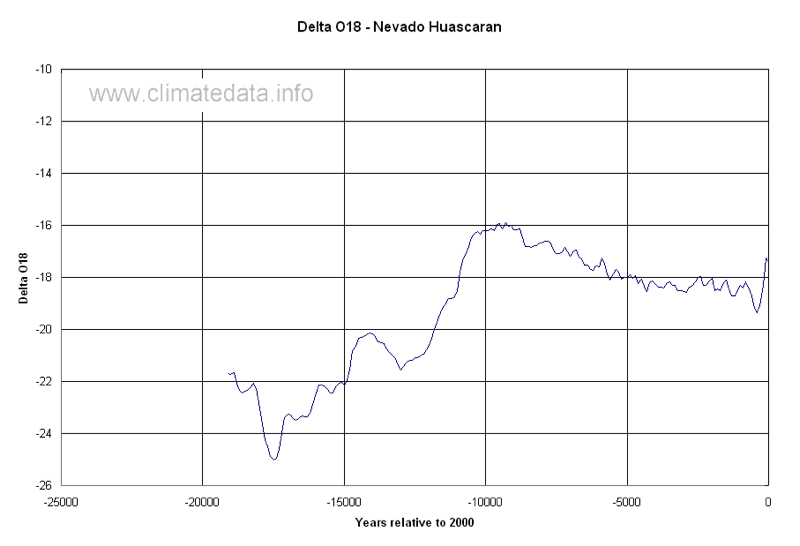ICE CORES
Ice cores are one of the most effective, though not the only, methods of recreating long term records of temperature and atmospheric gases.
Particularly in the polar region, but also at high elevations elsewhere, snow falls on an annual cycle and remains permanently. Over time, a few decades, the layers of snow compact under their own weight and become ice. By drilling through that ice, and recovering cylinders of it, it is possible to reconstruct records of temperature and of atmospheric gases for periods of hundreds of thousands of years.
Technologically the recovery of ice cores and their analysis is an amazing feat. Firstly as engineering: drilling thousands of metres in sub-zero temperatures, retrieving the cores and transporting them for analysis is a major feat. Secondly, to analyse the content of the air bubbles, and determine not only the proportion of different gases but also the proportion of specific isotopes of those gases is also technologically challenging.
Whilst ice cores allow direct measurement of atmospheric gases, like CO2 and Methane, some care is needed in interpreting the results. This is because of the fact that, while the snow is being compressed into ice, gas transfer may occur between the atmosphere and the layers of ice. Indeed, dating information is sometimes given for the “ice age” and “gas age”. Because the gases in the atmosphere are mixed and decay over time this adds another element of uncertainty. In effect, the data represent the average over a period of time, which can be several decades; a corollary of this is that data calculated from ice cores, for temperature of CO2 for example, will have less variation than the measured record.
Particularly in the polar region, but also at high elevations elsewhere, snow falls on an annual cycle and remains permanently. Over time, a few decades, the layers of snow compact under their own weight and become ice. By drilling through that ice, and recovering cylinders of it, it is possible to reconstruct records of temperature and of atmospheric gases for periods of hundreds of thousands of years.
Technologically the recovery of ice cores and their analysis is an amazing feat. Firstly as engineering: drilling thousands of metres in sub-zero temperatures, retrieving the cores and transporting them for analysis is a major feat. Secondly, to analyse the content of the air bubbles, and determine not only the proportion of different gases but also the proportion of specific isotopes of those gases is also technologically challenging.
Whilst ice cores allow direct measurement of atmospheric gases, like CO2 and Methane, some care is needed in interpreting the results. This is because of the fact that, while the snow is being compressed into ice, gas transfer may occur between the atmosphere and the layers of ice. Indeed, dating information is sometimes given for the “ice age” and “gas age”. Because the gases in the atmosphere are mixed and decay over time this adds another element of uncertainty. In effect, the data represent the average over a period of time, which can be several decades; a corollary of this is that data calculated from ice cores, for temperature of CO2 for example, will have less variation than the measured record.
http://www.climatedata.info/
Errors in the time of events identified in the ice core records can be in hundreds of years. The following graph shows ice ages estimated for the Vostok ice core by 4 different methods compared with “orbital tuning”. Orbital tuning refers to calibrating the times against the Milankovitch cycles and the associated changes in radiation (Figure 1).
In the case of temperature no direct measurement is possible. The temperature values are estimated from different isotopes of oxygen and hydrogen. The methodology is based on the assumption that different isotopes evaporate at different rates depending on the temperature. It is generally considered that the best estimate of temperature from ice cores is based on the use of both Oxygen-18 and Deuterium. Another complication is that ice is not stationary, which means that the ice collected at lower layers may not be the ice that was originally underneath the upper layers. Despite all of these limitations, it is generally accepted that ice cores give a good representation of temperature over very long periods. They are able to answer such questions as what drives the cycle of ice ages and warm periods and what is the role of CO2 in long-term climate change.
In the case of temperature no direct measurement is possible. The temperature values are estimated from different isotopes of oxygen and hydrogen. The methodology is based on the assumption that different isotopes evaporate at different rates depending on the temperature. It is generally considered that the best estimate of temperature from ice cores is based on the use of both Oxygen-18 and Deuterium. Another complication is that ice is not stationary, which means that the ice collected at lower layers may not be the ice that was originally underneath the upper layers. Despite all of these limitations, it is generally accepted that ice cores give a good representation of temperature over very long periods. They are able to answer such questions as what drives the cycle of ice ages and warm periods and what is the role of CO2 in long-term climate change.
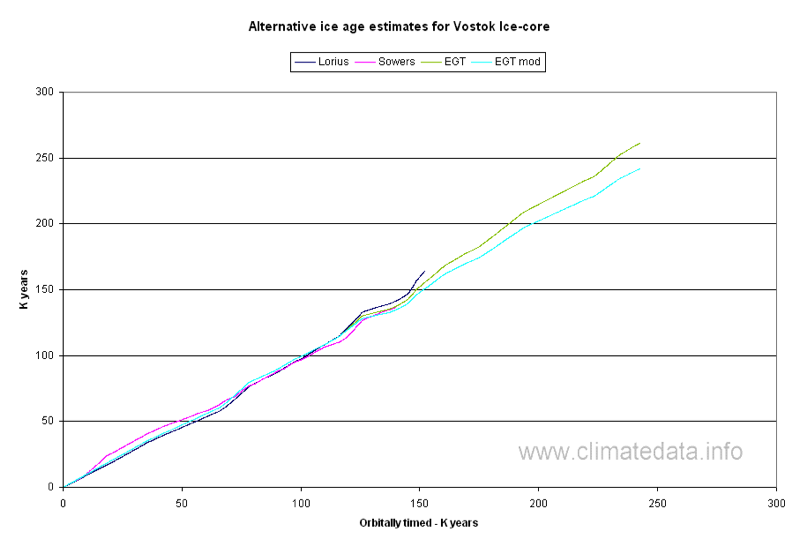
Antarctica
The deepest ice, and therefore the ice with the longest record, is found in Antarctica. As the ice in Antarctica is mostly over land, as opposed to the Arctic where most of the ice is floating on sea, this makes it ideal for deep core sampling. EPICA is the deepest of the ice cores and it also goes farthest back in time. Figure 2 shows the temperature and radiation data as calculated from the Milankovitch cycles. As can be seen, there is good agreement between the timing of orbital cycles and the temperature changes. It is also noticeable that there is a tendency for times of higher radiation to be associated with higher temperature but the correspondence is far from perfect. Figure 3 shows temperature and CO2. As can be seen, there is close correspondence in the timing and relative magnitude of the two variables. Although not clear from this chart there is general agreement that temperature changes precede CO2 changes during the rising phase and CO2 lags temperature by a larger amount during the falling phase. Figure 4 and Figure 5 show similar relationships for the Vostok ice core (note: EPICA ad Vostok are both in the Antarctic).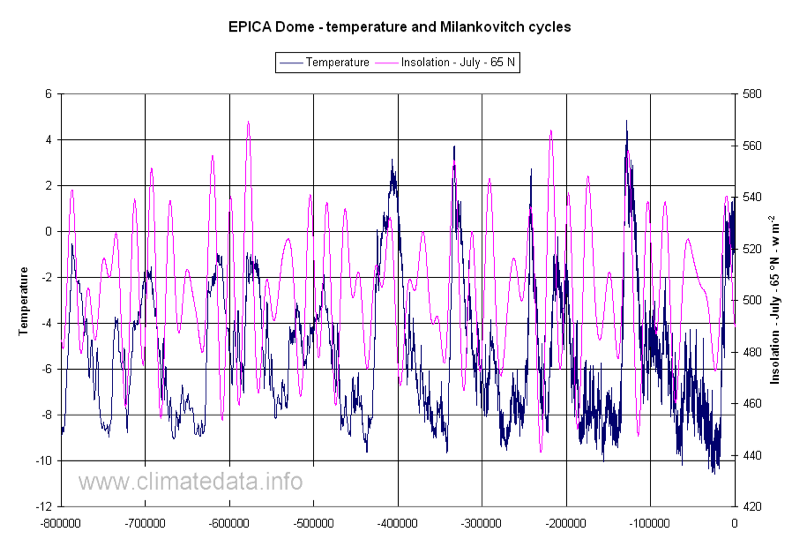
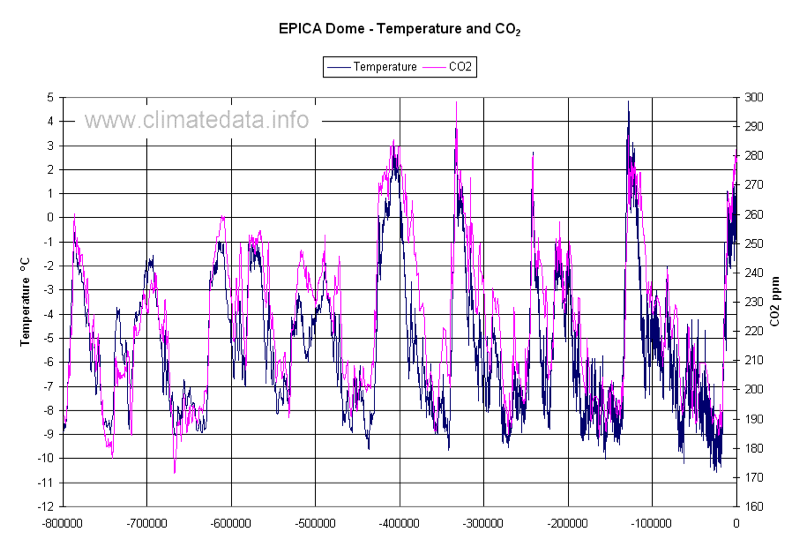
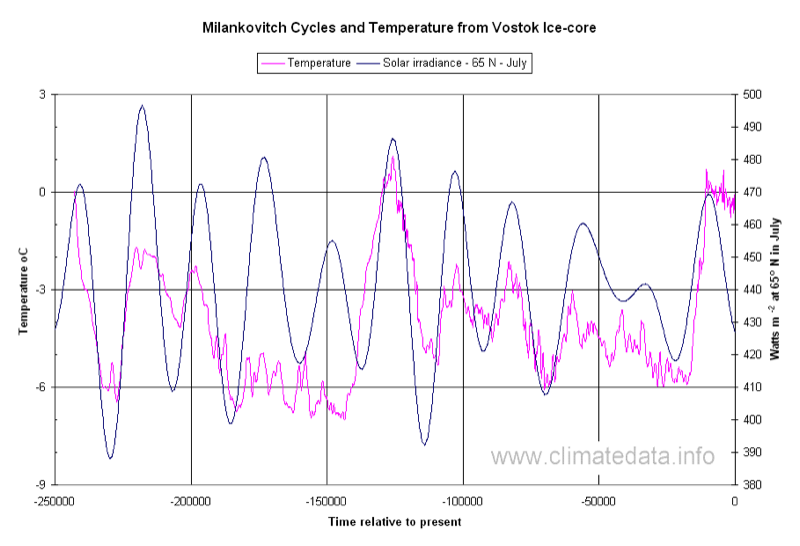
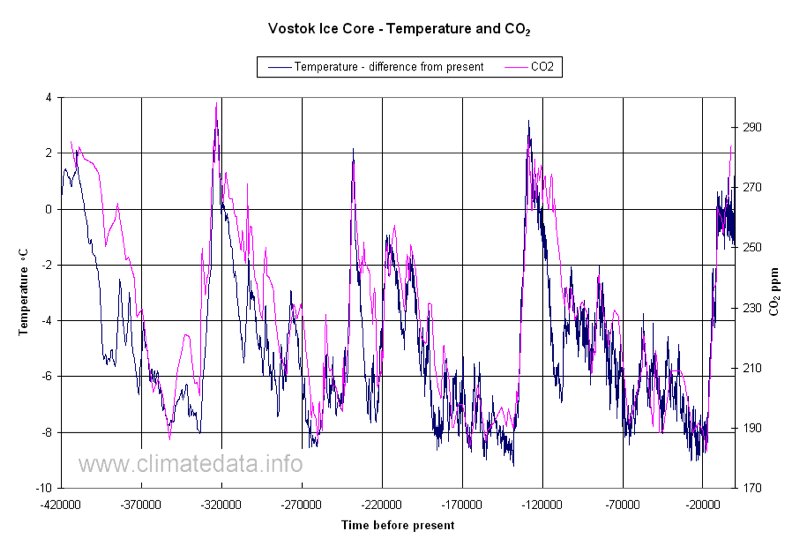
Figure 6 shows the temperature for both the EPICA and the Vostok sites, which indicated that the temperature records are in good agreement for most of the time. Before approximately 200,000 years ago there was some divergence in the estimate age but as can be seen in Figure 6 these differences are well within the range of likely errors.
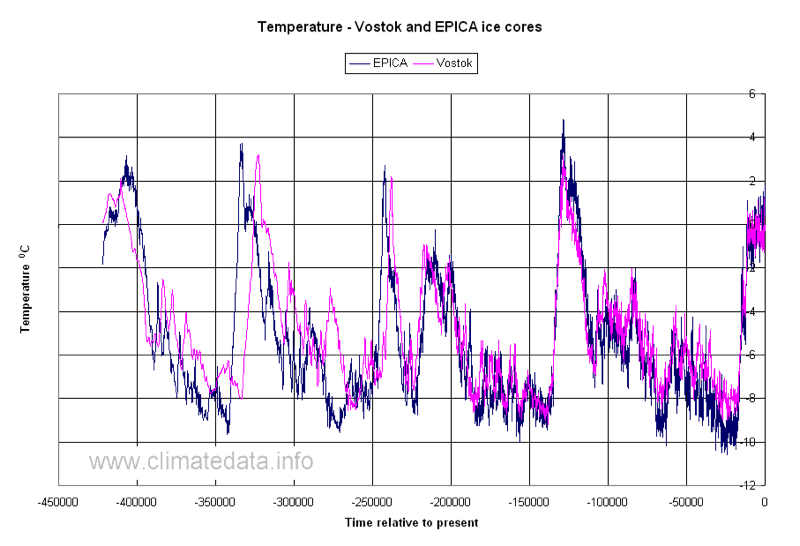
Arctic
Whilst the Antarctic is a continent, the only major area of land in the Arctic covered with snow is Greenland. There have been several ice cores drilled in Greenland but these core do not go as deep as those in the Antarctic. Figure 7 shows temperature calculated for the GISP2 Greenland ice core in comparison to the Vostok Antarctic ice core.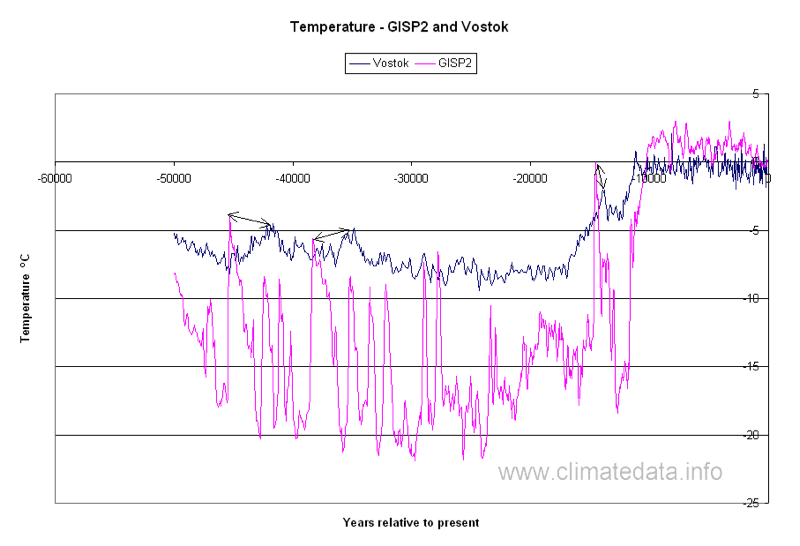
Tropics
Although, of course, most ice cores have been taken near the poles, some have been taken for tropical glaciers. Figure 8 shows the levels of Oxygen-18 from the Nevado Huascaran glacier in the Peruvian Andes. Levels of Oxygen-18 are positively correlated with temperature but this is reported not to be as accurate as when deuterium is also used in the calculation.